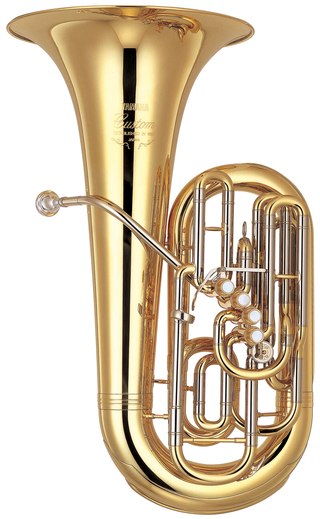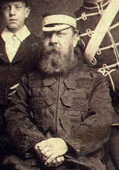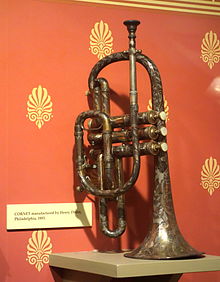
Antoine-Joseph "Adolphe" Sax was a Belgian inventor and musician who invented the saxophone in the early 1840s, patenting it in 1846. He also invented the saxotromba, saxhorn and saxtuba. He played the flute and clarinet.

The cornet is a brass instrument similar to the trumpet but distinguished from it by its conical bore, more compact shape, and mellower tone quality. The most common cornet is a transposing instrument in B♭. There is also a soprano cornet in E♭ and cornets in A and C. All are unrelated to the Renaissance and early Baroque cornett.

The euphonium is a medium-sized, 3 or 4-valve, often compensating, conical-bore, tenor-voiced brass instrument that derives its name from the Ancient Greek word εὔφωνος euphōnos, meaning "well-sounding" or "sweet-voiced". The euphonium is a valved instrument. Nearly all current models have piston valves, though some models with rotary valves do exist.

The flugelhorn, also spelled fluegelhorn, flugel horn, or flügelhorn, is a brass instrument that resembles the trumpet and cornet but has a wider, more conical bore. Like trumpets and cornets, most flugelhorns are pitched in B♭, though some are in C. It is a type of valved bugle, developed in Germany in the early 19th century from a traditional English valveless bugle. The first version of a valved bugle was sold by Heinrich Stölzel in Berlin in 1828. The valved bugle provided Adolphe Sax with the inspiration for his B♭ soprano (contralto) saxhorns, on which the modern-day flugelhorn is modeled.

The saxhorn is a family of valved brass instruments that have conical bores and deep cup-shaped mouthpieces. The saxhorn family was developed by Adolphe Sax, who is also known for creating the saxophone family. The sound of the saxhorn has a characteristic mellow tone quality and blends well with other brass.

The tuba is the lowest-pitched musical instrument in the brass family. As with all brass instruments, the sound is produced by lip vibration – a buzz – into a mouthpiece. It first appeared in the mid-19th century, making it one of the newer instruments in the modern orchestra and concert band. The tuba largely replaced the ophicleide. Tuba is Latin for "trumpet".

The baritone horn, sometimes called baritone, is a low-pitched brass instrument in the saxhorn family. It is a piston-valve brass instrument with a bore that is mostly conical, like the higher pitched flugelhorn and alto (tenor) horn, but it has a narrower bore compared to the similarly pitched euphonium. It uses a wide-rimmed cup mouthpiece like that of its peers, the trombone and euphonium. Like the trombone and the euphonium, the baritone horn can be considered either a transposing or non-transposing instrument.

The bugle is a simple signaling brass instrument with a wide conical bore. It normally has no valves or other pitch-altering devices, and is thus limited to its natural harmonic notes, and pitch is controlled entirely by varying the embouchure.

The tenor horn is a brass instrument in the saxhorn family and is usually pitched in E♭. It has a bore that is mostly conical, like the flugelhorn and euphonium, and normally uses a deep, cornet-like mouthpiece.

The mellophone is a brass instrument typically pitched in the key of F, though models in E♭, D, C, and G have also historically existed. It has a conical bore, like that of the euphonium and flugelhorn. The mellophone is used as the middle-voiced brass instrument in marching bands and drum and bugle corps in place of French horns, and can also be used to play French horn parts in concert bands and orchestras.

A brass quintet is a five-piece musical ensemble composed of brass instruments. The instrumentation for a brass quintet typically includes two trumpets or cornets, one French horn, one trombone or euphonium/baritone horn, and one tuba or bass trombone. Musicians in a brass quintet may often play multiple instruments. Trumpet players for instance may double on piccolo trumpets and flugelhorns. There can be variation in instrumentation depending on the type of quintet. In some quintets, the horn is replaced by an additional trombone. Euphonium may also be substituted for the trombone part. While the tuba is considered a standard, the range and style of many pieces lend themselves to being played with bass trombone as the lowest-pitched instrument. Additionally, some pieces call for the use of percussion instruments, particularly the snare drum, tambourine, or timpani.

The ophicleide is a family of conical-bore keyed brass instruments invented in early 19th-century France to extend the keyed bugle into the alto, bass and contrabass ranges. Of these, the bass ophicleide in C or B♭ took root over the course of the 19th century in military bands and as the bass of orchestral brass sections throughout Western Europe, replacing the serpent and its later upright derivatives. By the end of the 19th century however, it had been largely superseded by early forms of the modern tuba, developed from valved ophicleides.
The Grammy winning Chestnut Brass Company is a Philadelphia brass quintet founded in 1977. Since beginning as a street band in Philadelphia in 1977, they have performed in North and South America, Europe, the Caribbean, and Asia.

Besson is a manufacturer of brass musical instruments. It is owned by Buffet Crampon, which bought Besson in 2006 from The Music Group.

The subcontrabass tuba is a rare instrument of the tuba family built an octave or more below the modern contrabass tuba. Only a very small number of these giant novelty instruments have ever been built. Most are pitched in 36’ BBB♭ an octave lower than the BB♭ contrabass tuba, its fundamental B♭-1 corresponding to a practically inaudible 15 Hz.

The saxotromba is a valved brass instrument invented by the Belgian instrument-maker Adolphe Sax around 1844. It was designed for the mounted bands of the French military, probably as a substitute for the French horn. The saxotrombas comprised a family of half-tube instruments of different pitches. By about 1867 the saxotromba was no longer being used by the French military, but specimens of various sizes continued to be manufactured until the early decades of the twentieth century, during which time the instrument made sporadic appearances in the opera house, both in the pit and on stage. The instrument is often confused with the closely related saxhorn.

Alfred James Phasey was a British bandsman and tenor brass artist in the mid-nineteenth century. As a euphonium player, he was cited as the master of the instrument in his time.
British Bandsman was a magazine published weekly devoted to British brass band music. It was founded in 1887 by Sam Cope (1856–1948) and acquired by The Salvation Army in 2004, before being sold in April 2015 to KGC Media Ltd., a company formed by the publication's then managing editor. In August 2014, it was confirmed by Guinness World Records as the world's oldest weekly music magazine.

A horn is any of a family of musical instruments made of a tube, usually made of metal and often curved in various ways, with one narrow end into which the musician blows, and a wide end from which sound emerges. In horns, unlike some other brass instruments such as the trumpet, the bore gradually increases in width through most of its length—that is to say, it is conical rather than cylindrical. In jazz and popular-music contexts, the word may be used loosely to refer to any wind instrument, and a section of brass or woodwind instruments, or a mixture of the two, is called a horn section in these contexts.

The keyed bugle is a wide conical bore brass instrument with tone holes operated by keys to alter the pitch and provide a full chromatic scale. It was developed from the bugle around 1800 and was popular in military bands in Europe and the United States in the early 19th century, and in Britain as late as the 1850s.























